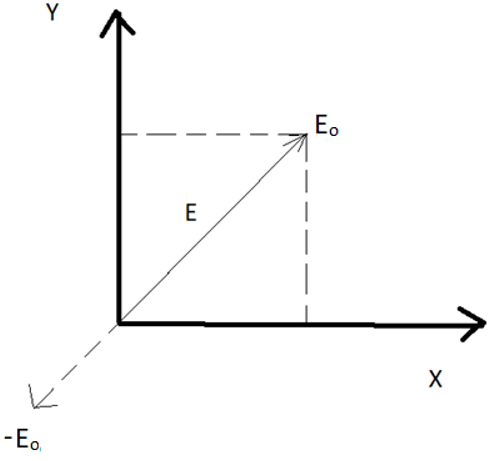This set of Engineering Physics Multiple Choice Questions & Answers (MCQs) focuses on “Polarization”.
1. A window which can transmit all the incident light without any reflection is called ___________
a) Polarized Window
b) Malus Window
c) Brewster Window
d) Non-reflecting window
View Answer
Explanation: Brewster’s window is the practical use of Brewster law. When light is incident on a clean glass plate, most of the incident light (>> 92%) is transmitted while a small fraction is reflected.
2. What should be the phase difference between the two plane-polarized waves, vibrating at right angles to each other, to produce circularly polarized light?
a) π/6
b) π/2
c) π/4
d) π/3
View Answer
Explanation: The circularly polarized light is produced when the phase difference between the two rays is π/2 and the angle of incidence is π/4. In that case, the equation of the polarized light turns out to be x2 + y2 = a2, which is the equation of the circle.
3. Sound waves can be polarized.
a) True
b) False
View Answer
Explanation: Longitudinal waves cannot be polarized as their direction is the same as its vibration. Thus, it’s intensity will not change as it passes through a rotating analyzer.
4. Which of the following is a uniaxial crystal?
a) Borax
b) Mica
c) Quartz
d) Selenite
View Answer
Explanation: Uniaxial crystals are those in which there is only one optic axis. Calcite, quartz, ice are a few examples. Borax, mica, and selenite are biaxial crystals which have two optic axes.
5. If the phase difference between two rays is π/2 and the angle of incidence is not equal to π/4, the emergent light is __________
a) Linearly Polarized
b) Elliptically Polarized
c) Circularly Polarized
d) Non-Polarized
View Answer
Explanation: In this case, the equation of the emergent light becomes the equation of an ellipse, which is \(\frac{x^2}{a^2}+\frac{y^2}{b^2}\) =1. Thus, the emergent light is elliptically polarized and the plane of the ellipse is normal to the direction of propagation.
6. The velocity of light in water is 2.2 X 108 m/s. What is the polarizing angle of incidence?
a) 47.23
b) 51.02
c) 53.74
d) 65.36
View Answer
Explanation: Refractive index of water = Speed of light in space/Speed of light in water
= 3/2.2
= 1.3636
Using Brewster’s Law, Angle of incidence = tan-1μ
= tan-11.3636
= 53.74.
7. An electromagnetic beam has an intensity 28 W/m2 and is linearly polarized vertically. What is the intensity of the transmitted beam, if the angle of incidence on the polaroid is 45o with the vertical?
a) 10 Wm-1
b) 12 Wm-1
c) 14 Wm-1
d) 16 Wm-1
View Answer
Explanation: Here, Io = 28 Wm-2, θ = 45
Using Malus law, I = Iocos2θ
I = 28 X cos245
I = 14 Wm-1.
8. What should be the thickness of quarter-wave plate for a light of wavelength 5890 Å if µe = 1.553 and µo = 1.544?
a) 1.33 X 10-3 cm
b) 1.43 X 10-3 cm
c) 1.53 X 10-3 cm
d) 1.63 X 10-3 cm
View Answer
Explanation: t = \(\frac{\lambda}{4(μ_E-μ_0)}\)
Λ = 5890 Å = 5890 X 10-8 cm, µe = 1.553 and µo = 1.544
Therefore, t = 5890a X 10-8/4 X 0.009
= 1.63 X 10-3 cm.
9. A tube of length 20cm containing a 10% sugar solution rotates the plane of polarization by 13.2°. What is the specific rotation of sugar solution?
a) 66°
b) 55
c) 44
d) 33
View Answer
Explanation: The specific rotation is given by S = 10θ/lC
Here, θ = 13.2°, C = 0.1 g/cc and l = 20 cm
Therefore, S = 10 X 13.2/20 X 0.1
= 66°.
10. Unpolarized light is incident on a plane glass surface. What should be the angle of incidence such that the reflect and refracted rays are perpendicular to each other?
a) 90°
b) 45°
c) 57°
d) 60°
View Answer
Explanation: Using Brewster’s Law, µ = tanip
In this case, i + r is equal to π/2.
For glass, µ = 1.5
Therefore, ip = tan-1µ = 57°.
11. A plate which induces the desired amount of phase difference between two rays is known as ___________
a) Polaroid
b) Phasor plates
c) Retardation Plates
d) Quartz plates
View Answer
Explanation: Sometimes, it is required to induce a certain phase difference between E-ray and O-ray. For that, a plate with a specific thickness is chosen to induce that phase difference. This plate is known as the retardation plate as it retards the motion of one of the rays.
12. What does the following graph show?

a) Linearly Polarized Light
b) Unpolarized Light
c) Partially Polarized Light
d) Circular Polarized Light
View Answer
Explanation: The graph shows a linearly polarized light. The vibrations are restricted in the x-y plane. Such a polarized light is obtained by using a polarizer/Polaroid and the phenomenon is called polarization of light.
Sanfoundry Global Education & Learning Series – Engineering Physics.
To practice all areas of Engineering Physics, here is complete set of 1000+ Multiple Choice Questions and Answers.
If you find a mistake in question / option / answer, kindly take a screenshot and email to [email protected]
